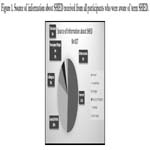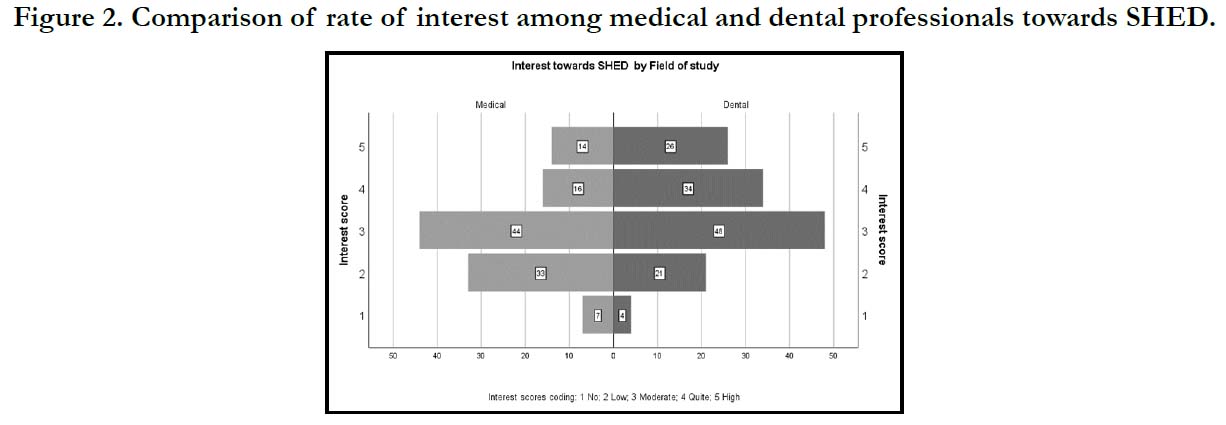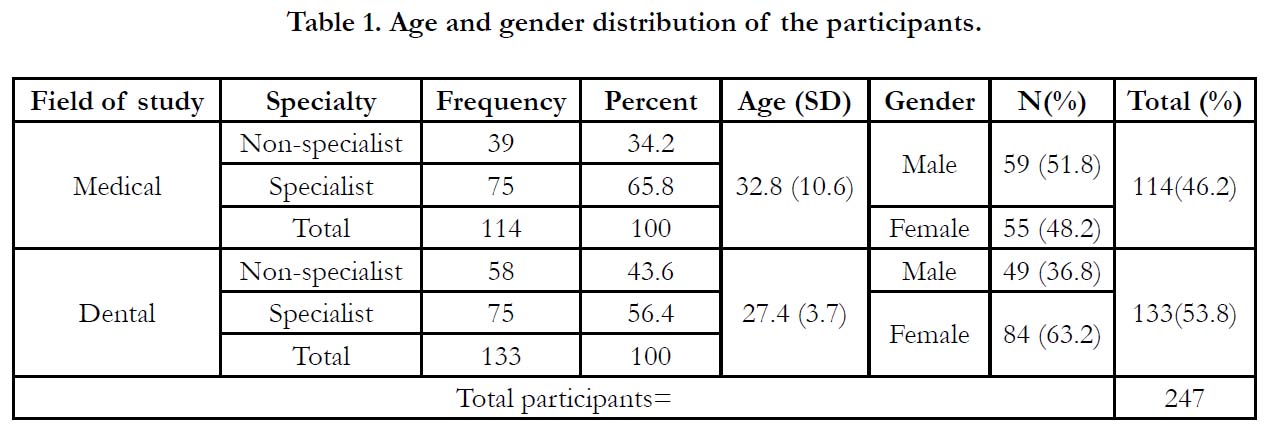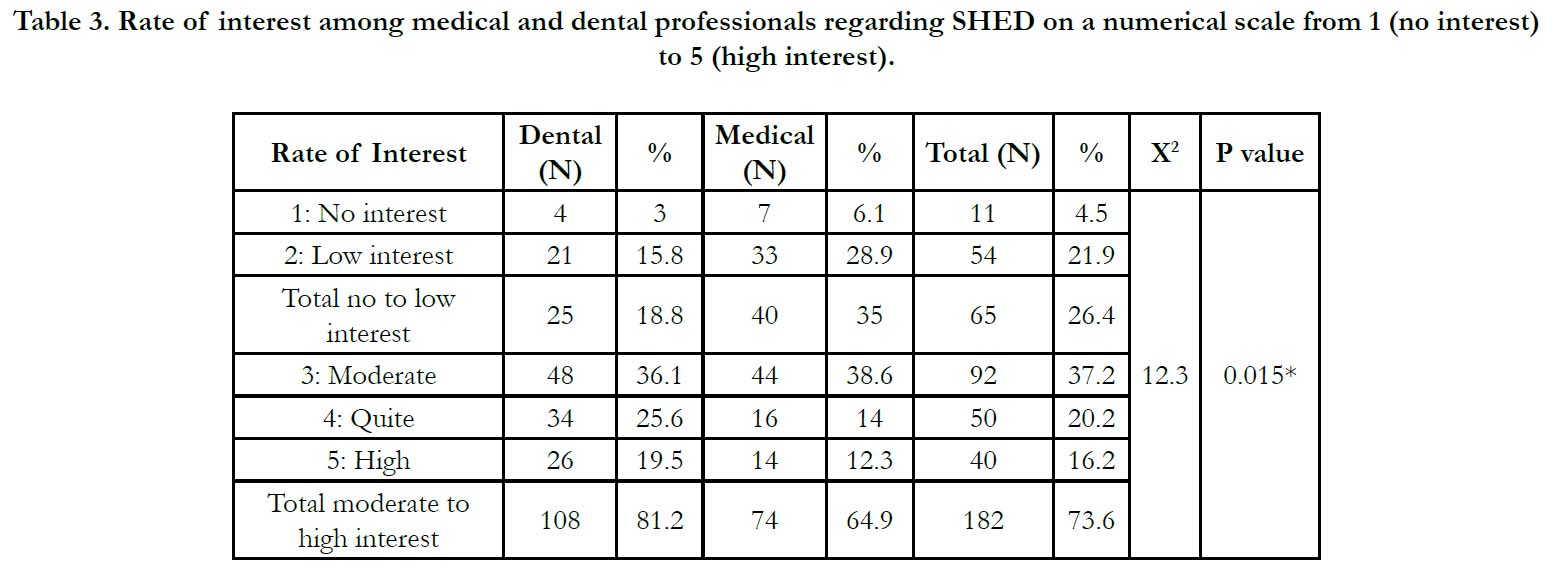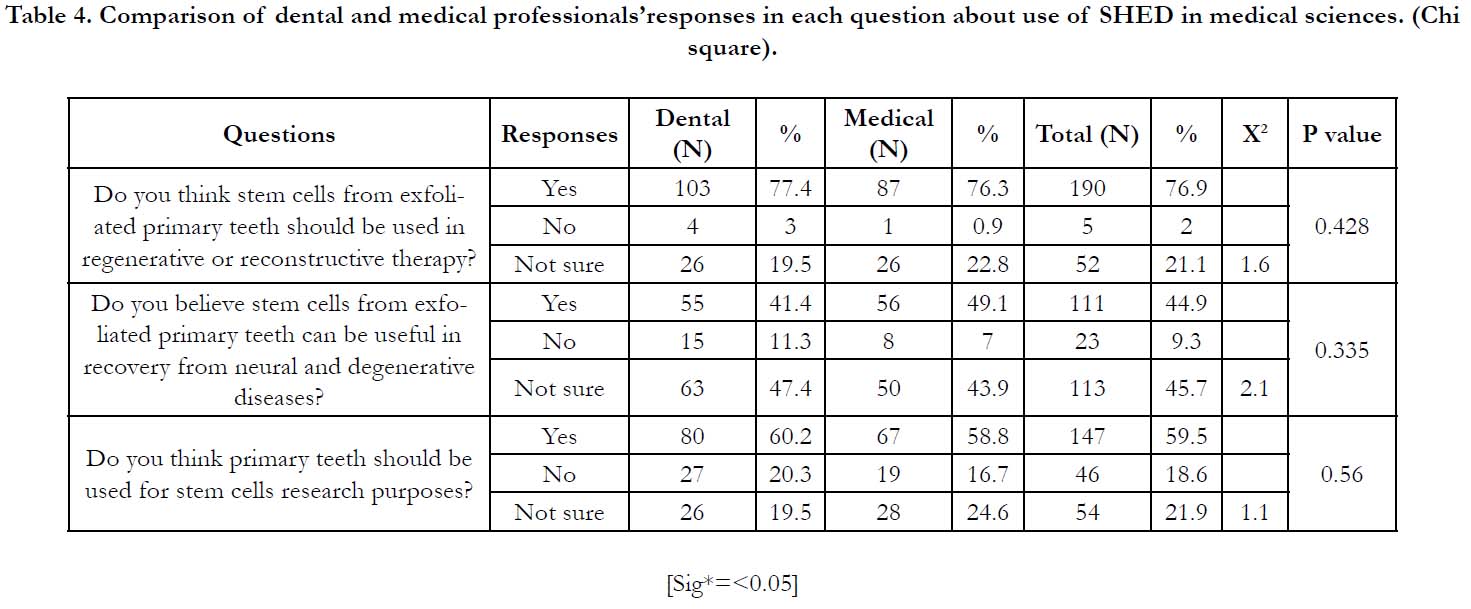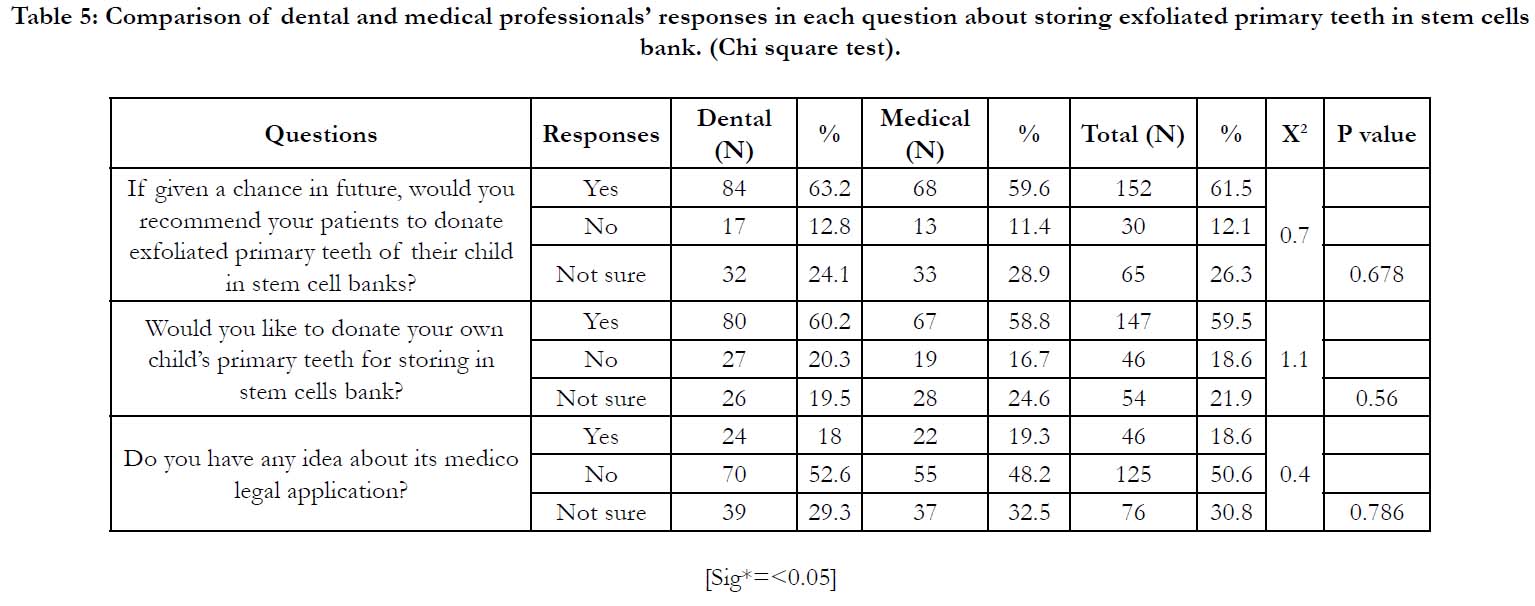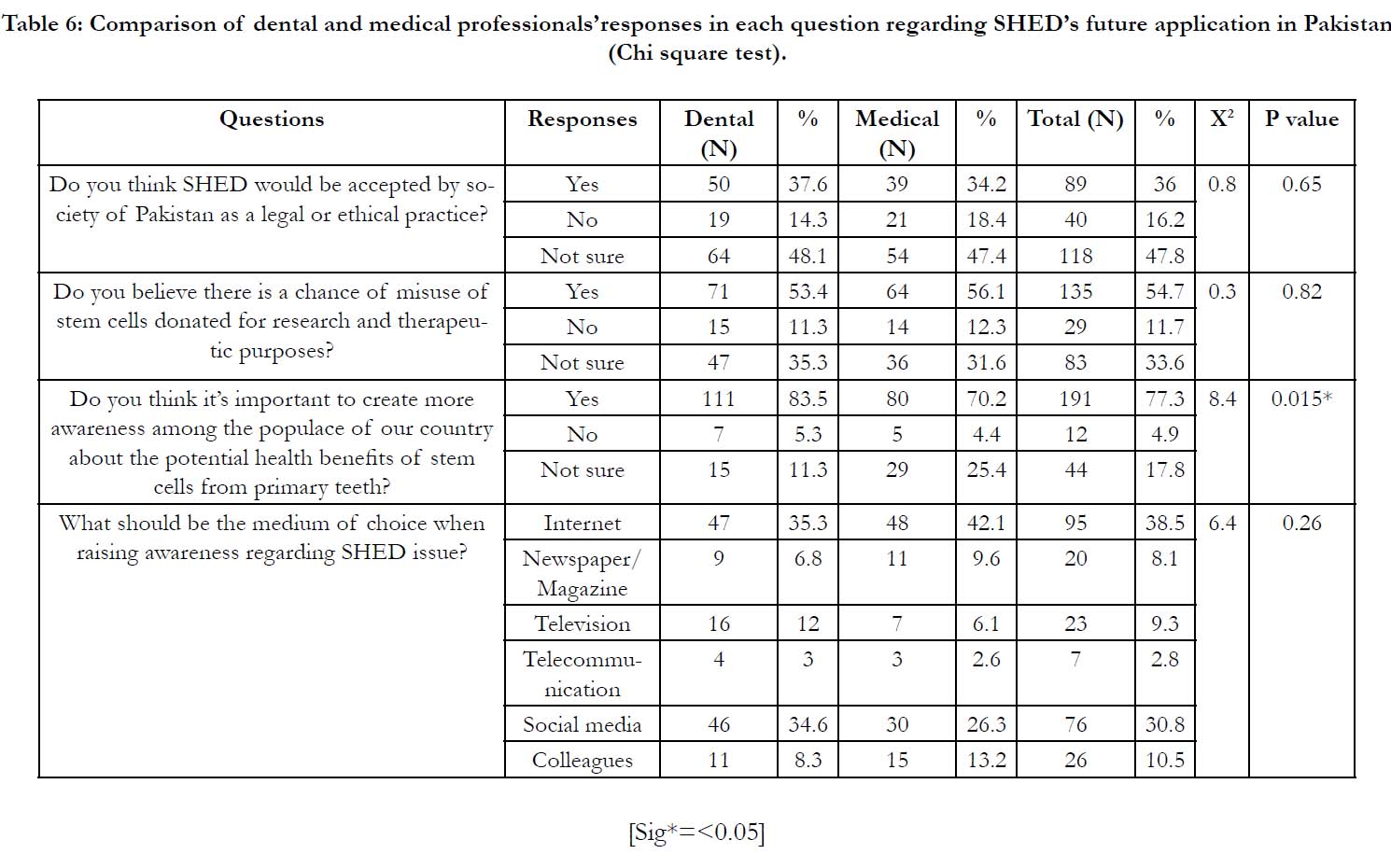Perception And Attitude Of Health Professionals Of Pakistan Towards Stemcells From Human Exfoliated Deciduous Teeth (SHED) Practice
Maria Khadija Siddiqui1, Hana Pervez2*, Marium Khawaja3, Shaqufta Naqvi4, Marium Iqbal5, Arif Mansoor6
1 Department of Community Dentistry, Jinnah Medical and Dental College, Karachi, Pakistan.
2 Department of Orthodontics, Jinnah Medical and Dental College, Karachi, Pakistan.
3 Department of Community Dentistry, Jinnah Medical and Dental College, Karachi, Pakistan.
4 Department of Community Health Sciences, Jinnah Medical and Dental College, Karachi, Pakistan.
5 Department of Operative Dentistry, Jinnah Medical and Dental College, Karachi, Pakistan.
6 Department of Biochemistry, Jinnah Medical and Dental College, Karachi, Pakistan.
*Corresponding Author
Dr. Hana Pervez,
Assistant professor, Department of Orthodontics, Jinnah Medical and Dental College, Karachi, Pakistan.
Tel: +92-3323738926
E-mail: drhanapervez@gmail.com
Received: November 27, 2021; Accepted: March 10, 2023; Published: March 13, 2023
Citation: Maria Khadija Siddiqui, Hana Pervez, Marium Khawaja, Shaqufta Naqvi, Marium Iqbal, Arif Mansoor. Perception And Attitude Of Health Professionals Of Pakistan
Towards Stemcells From Human Exfoliated Deciduous Teeth (SHED) Practice Int J Dentistry Oral Sci. 2023;10(2):5324-5329.
Copyright: Hana Pervez©2023. This is an open-access article distributed under the terms of the Creative Commons Attribution License, which permits unrestricted use, distribution and reproduction in any medium, provided the original author and source are credited.
Abstract
The application of SHED isa novel advancement in the field of medicine. To estimate its successful execution in Pakistan, it is important to estimate Pakistani health professionalsí perception and attitude towards SHED practice, at earliest.Therefore, this study was conducted, to assess the interest among dental and medical professionals of Karachi towards SHED (Stem cells from exfoliated deciduous teeth),their perception of its uses in medical science and its prospective future in Pakistan.A cross-sectional study was conducted among medical and dentalprofessionals working in urban areas of Karachi. A convenient sampling procedure was used, where247 out of 270 distributed questionnaires were received back (Response rate: 91.48%). Moderate interest was demonstrated by both types of professionals towards SHED. Dental professionals have exhibited significantly (p=0.015)more (moderate to high) interest(81.2%), than medical professionals (64.9%).Both dental (63.2%) and medical (59.6%) professionals agreed on primary teeth banking.Both groups (dental 48.1%and medical 47.4%) were not sure about an acceptance of SHED by the society of Pakistan, as an ethical practice. According to this study, not many Pakistani health professionals are aware of the term SHED and they seem unsure about its recognitionin Pakistan, as an ethical practice. Thus, it is recommended that health professionals of Pakistan should be educated regarding benefits of SHED and its limited ethical concern, to help them develop confidence in its use.
2.Case Report
3.Discussion
4.Conclusion
5.References
Keywords
Perception; Dental Stem Cells; SHED (Stem Cells from Exfoliated Deciduous Teeth); Tooth Bank.
Introduction
The discovery of stem cells is a significant advancement in regenerative
medicine [1]. There are primarily two types of stem cells,
namely embryonic stem cells (ESCs) and adult stem cells (ASCs)
or somatic cells, depending on the developmental stage from
which they are obtained [2]. Dental stem cell (DSC) is a type of
ASC, which based on its originisfurther classified into: dental pulp
stem cells(DPSCs), stem cells from human exfoliated deciduous
teeth(SHED), periodontal ligament derived stem cells (PDLSCs),
dental follicle stem cells (DFSCs), tooth germ progenitor cells obtained
from third molars (TGPCs), immature dental pulp stem
cells from deciduous teeth (IDPSCs) and stem cells from the apical
papilla (SCAP)[3-7].
So far, the best multipotent and proliferative results from
anyDSCsthat have beenobservedare from SHED,evolving,tissue
engineering and regenerative medicine [8, 9]. SHED has demonstrated
MSC (mesenchymal stem cells) like capacity for selfrenewal
and multilineage differentiation potential [10]. They have
shown abilities to repair damaged tooth structures, promote bone
regeneration and treat neural tissue injury or degenerative diseases
[11]. SHEDs are also easier to obtain, carrying no major ethical
constraints [3]. Therefore, they are more favourable to use in
medicine than any other stem cells.
The application of SHED in Pakistan could bea promisingnovel
advancement in the field of medicine. However, complete awareness
and specialized skills in this areaare required.Thus, to estimate
its future successful execution in Pakistan, it is important
to estimate Pakistani health professionalsí perception and their
attitudes towards SHED practice.
Therefore, this study was conducted to estimate the interestin-
SHED, among medical and dental professionals from Karachi
and perception ofits use inmedical sciences including research and
tissue regenerative/reconstructive therapies. Moreover, the study
also aimed to estimate choices towards donation of exfoliated primary
teeth in stem cell banks when given a chance. The objectives
of this study are as follows:
ē To assess perceptions of use of SHED in medical sciences,
amongmedical and dental professionals.
ē To assess attitude towards storage of primary teeth in stem cell
bank,among medical and dental professionals.
ē To assess perceptions related to future application of SHED in
Pakistan among medical and dental professionals.
ē To assess the level of interest among medical and dental professionals
towards subject of SHED
Materials And Methods
Study design and Sampling: This cross-sectional study was
conducted among medical and dental professionals working in
random private and public health-care setups, including educational
institutions, clinical offices and tertiary care in urban areas
of Karachi. A convenient sampling procedure was used. Medical
and dental professionals, currently practising in their respective
fields were included as study participants. Minimum sample size
of 150 was required, using 95% confidence level, 5% bound on
the error of estimation and using 89% prevalence of interest in
stem cells, [12, 13]. Finally, 135 professionals in each medical and
dental group were recruited, making actual sample size of 270.
Data collection and Questionnaire: The data collection was
done using self-constructed questionnaires. The questionnaire
comprises 17 questions, which were primarily derived from previous
dental surveys using careful consideration for question type,
wording and layout. The questionnaire was designed to collect
data including; demographic background andfield of speciality of
participants. Besides that, ithasquestions regarding:awareness of
term SHED, use of SHED in medicinefor research purpose and
for regenerative therapy, interest level on a Likert scale of 5, attitude
towards stem cell donation/storage in stem cell bank and
future of SHED practice in Pakistan.
Statistical Analysis: Data obtained was analysed using SPSS
software 21. For descriptive statistics, variables were categorized;
and frequencies and percentages were calculated. Proportions in
response between dental and medical groups were compared using
chi-square test. Pvalue of <0.05 was considered statistically
significant.
Ethical consideration: Verbal consent was taken prior to data
collection from every participant. Ethical clearance was obtained
from the Ethical Review Committee of Jinnah medical and dental
college, Karachi, Pakistan. The ethical protocol number is
(000025/20). This study was conducted between December 2019
to June 2020.
Results
A total of 247 completely filled, out of 270 distributed questionnaires
were received back by the researcher. The completely filled
forms were received from 114 medical and 133 dental professionals,
making response rate of 91.48%. Age and gender distributions
are given in Table 1.
More than half of participants, [56.68% (n=140)] had never
heardabout term SHED before, and majority of them are medical
professionals [30.7% (n=76)] as shown in Table 2. Only 43.3%,
(n=107) of all professionals were familiar with theterm SHED
and the most frequent source of information was the internet
[51.40%(n=55)], followed by the Journal/Article [29.90 %(n=32)]
(Figure 1).
Both professional groups have shown moderate level of interest
towards SHED (38.6% medical and 36.1% dental), which is level
3 on Likert scale (Figure 2). Significant difference (p=0.015) in the
interest towards SHED was observed between the two groups,
where dental professionals have exhibited more interest (moderate
to high) in SHED [81.2% (n=108)] than medical professionals
[64.9% (n=74)] as presented in Table 3.
Both groups ofprofessionals, (dental 77.4%,n=103 and medical
76.3%, n=87)believed that SHED should be used in regenerative
or reconstructive therapy (Table 4). About half of the medical
professionals(49.1%, n=56) believe that the stem cells from exfoliated
primary teeth can be useful in recovery from the neural and
degenerative diseases, whereas, most dental professionals (47.4%,
n=63) were not sure about it (Table 4). Both dental 60.2% (n=80)
and medical 58.8%(n= 67) professionals, believe in possibility of using stem cells from primary teeth for the research purposes (Table
4).
Both dental (63.2%, n=84) and medical (59.6%,n=68) professionals
agreed on recommending their patients, to donate their
childís exfoliated teeth, along their own childís primary teeth (dental
60.2n=80 and medical 58.8% n=67) instem cell bank (Table
5). However, majority 50.6%, (n=125) of respondentshad no idea
aboutmedico-legal implications of SHEDís donation in stem cell
banks (Table 5).
Both groups, (dental 48.1%, n=64 and medical 47.4%, n=54)
were not sure about an acceptance of SHED by the society of
Pakistan, as a legal or ethical practice (Table 6). Moreover, more
than half of them 54.7% (n=135) believed that there is a chance
of misuse of stem cells, donated for research and therapeutic purposes
(Table 6). High positive response was received from both
groups, [dental; 83.5% (n=111) andmedical; 70.2%(n=80)], when
asked about creating awareness among the populace of Pakistan
regarding the benefits ofSHED practice, however, significant difference
(p=0.015) appeared in responses. Overall, most of the
respondents have considered internet (38.5%) as the medium
of choice for raising SHED awareness, followed by social media(
30.8%) (Table 6).
Figure 1. Source of information about SHED received from all participants who were aware of term SHED.
Table 3. Rate of interest among medical and dental professionals regarding SHED on a numerical scale from 1 (no interest) to 5 (high interest).
Table 4. Comparison of dental and medical professionalsíresponses in each question about use of SHED in medical sciences. (Chi square).
Table 5: Comparison of dental and medical professionalsí responses in each question about storing exfoliated primary teeth in stem cells bank. (Chi square test).
Table 6: Comparison of dental and medical professionalsíresponses in each question regarding SHEDís future application in Pakistan (Chi square test).
Discussion
The domain of stem cell research has emerged with various medical
and dental applications, due tostem cellís abilities to regenerate
and repair damaged tissues [14]. Likewise, SHEDís various prospective
medical and dental uses have necessitated, building an
interest in applications of SHED, among medical and dental professionals.
Therefore, this study was intended to evaluate interest
level and practice of stem cell from human exfoliated deciduous
teeth (SHED), among medical and dental professionals of Pakistan.
Due to availability of limited previous original studies, specifically
related to SHED, results of current study have been compared
with results of similarly designed previous studies, however,
done on stem cells in general or on DSCs.
According to the results of the current study, more than half of
the participants hadnever heard about SHED before. Interestingly,
moremedical professionals were unaware compared to the
dental professionals. Among all participants, the most frequent
source of information was the internet, followed by the journal/
article. Likewise, in an Indian study, a large proportion (74%) of
dentists was well-aware of dental stem cells (DSCs) and the most
frequent source of information was journals, followed by internet
[15].
Interest among professionals:
In this study, both medical and dental professionals demonstrated
a moderate level of interest in stem cells from exfoliated deciduous
teeth (SHED).Comparatively, dental professionals have exhibited
more interest (moderate to high) in SHED than medical
professionals. This is parallel toanother Indian study,wherealmost
all of the responding dentists have shown interest in learning
about application of stem cells, when given a chance [16]. A study
conducted involving medical doctors of Italy, found that the majority
of physicians (70%) were interested in stem cells and believed
in the potential benefits of developing stem cells strategies
in their country [17]. Similarly,in our study, although, proportion
of medical respondents, showing moderate to high interest in the
subject of SHED was not high (64%), it was more than half of
the respondents.
Use in medicine for therapy and research purpose
SHED has been proven to be beneficial in repairing and treatingneural
tissue injuries and degenerative diseases [11, 18]. In the
current study, majority of medical professionals agreed to the
fact that SHED can be useful in recovery from the neural and
degenerative diseases. This responseis similar to the findings froma
study conducted on health care providers in Saudi Arabia, in
which prominent number of the health professionals confirmed
that stem cells can be used to treat neurological problems such
as Alzheimerís and Parkinsonís diseases(19). The concept of regeneration
instead of repair will be the reason why medical professionals
would recommend stem cell-based regenerative treatments
to their patients (13). Unlike medical professionals, dental
professionals were not sure about the use of SHED to treat neurological
and degenerative diseases, in the current study.
Both the professionals in our study, showed willingness to use primary
teeth as a source of stem cells for the purpose of research.
Results showed similarity with a survey, conducted on the health
professionals in China, in which majority of the participants, expressed
high level of interest in stem cellsuse, for research [20].
Stem cell Bank donation:
Dental stem cells are considered a viable source of ASCs, as they
can be easily obtained by tooth extraction [21]. This has led to
an increase in the popularity of tooth banking and harvesting of
dental stem cells for allogenic and autologous cell therapy [22].
Majority of dental and medical professionals in our study, agreed
on recommending to their patients, to donate their childís exfoliated
teeth. Similarly, according to Indian studies, majority of
health professionals were willing to recommend their patients to
donate their teeth for preservation of the dental stem cells [11,
23]. When asked about their own childís teeth, two-third of both
the dental and medical respondents agreed on donating their
childís exfoliated teeth in stem cell bank, in our study. This is in
contrast with the Iranian study, where only 45.2% of the dentists
were interested in collecting and storing dental tissues for stem
cell banking [24]. Although, health professionals have agreed on
donating exfoliated teeth in stem cell bank in our study,majority
of them had no idea about medico-legal implications of SHEDís
donation in stem cell banks.
Ethical practice and future application in Pakistan:
In current study, both professional groups were not sure about an
acceptance of SHED by the general public of Pakistan, as a legal
or ethical practice. More than half of them believed that there is
a chance of misuse of stem cells, donated for research and therapeutic
purposes. This is different from Saudidentistsí perception
on stem cells, who believed that use of stem cells did not contradict
ethical and religious principles [25].
Nevertheless, majority of participants in both groups, (83.5%,
dental and 70.2%, medical), agreed on creating awareness among
the populace of Pakistan about the benefits of SHED practice,
this time resemblingthe same Saudi study, in which almost all the
participants recommended more public awareness programs,
about stem cells and their therapeutic applications [25]. In the
current study, medium of choice chosen by health professionals
to promote SHED awareness was internet, followed by social
media. Whereas, according to Indian study, dentists preferred
seminars and conferences, to increase dental stem cells awareness
followed by journals and advertisements [15].
One of the limitations of this study is narrow availability of original
studies related to beliefs and attitude of health care professionals
towards SHED. Most of the studies discovered, were focused
on dental stem cells, which has led to limitedspecific comparison
in the current study, aiming SHED.
Understanding of SHED practice will open a new era of research
and prospective advancement inthe treatment of various diseases.
However, at present many Pakistani health professionals are still
new to the term SHED, according to the study. Moreover, despite
showing moderate interest, many health professionals seem
unsure about recognition of SHED, as an ethical practice in Pakistan.
Thus, it is recommended that health professionals of Pakistan
should be educated regarding benefits of SHED and its limited ethical concern, tohelp them develop confidence in its use.
References
-
[1]. Martinez Saez D, Sasaki RT, Neves AD, da Silva MC. Stem Cells from Human
Exfoliated Deciduous Teeth: A Growing Literature. Cells Tissues Organs.
2016;202(5-6):269-280. PubMed PMID: 27544531.
[2]. Fortier LA. Stem cells: classifications, controversies, and clinical applications. Vet Surg. 2005 Sep-Oct;34(5):415-23. PubMed PMID: 16266332.
[3]. Huang YH, Yang JC, Wang CW, Lee SY.Dental stem cells and tooth banking for regenerative medicine. J ExpClin Med. 2010 Jun 1;2(3):111-7.
[4]. Kerkis I, Caplan AI. Stem cells in dental pulp of deciduous teeth. Tissue Eng. Part B: Reviews. 2012 Apr 1;18(2):129-38.
[5]. Rai S, Kaur M, Kaur S. Applications of stem cells in interdisciplinary dentistry and beyond: an overview. Ann Med Health Sci Res. 2013 Apr;3(2):245- 54. PubMed PMID: 23919198.
[6]. Chopra H, Hans MK, Shetty S. Stem cells-the hidden treasure: A strategic review. Dent Res J (Isfahan). 2013 Jul;10(4):421-7. PubMed PMID: 24130574.
[7]. Arora V, Arora P, Munshi AK. Banking stem cells from human exfoliated deciduous teeth (SHED): saving for the future. J ClinPediatr Dent. 2009 Summer;33(4):289-94. PubMed PMID: 19725233.
[8]. Nakamura S, Yamada Y, Katagiri W, Sugito T, Ito K, Ueda M. Stem cell proliferation pathways comparison between human exfoliated deciduous teeth and dental pulp stem cells by gene expression profile from promising dental pulp. J Endod. 2009 Nov;35(11):1536-42. PubMed PMID: 19840643.
[9]. Giordano G, La Monaca G, Annibali S, Cicconetti A, Ottolenghi L. Stem cells from oral niches: a review. Ann Stomatol (Roma). 2011 Jan;2(1-2):3-8. PubMed PMID: 22238715.
[10]. Chalisserry EP, Nam SY, Park SH, Anil S. Therapeutic potential of dental stem cells. J Tissue Eng. 2017 May 23;8:2041731417702531. PubMed PMID: 28616151.
[11]. Miura M, Gronthos S, Zhao M, Lu B, Fisher LW, Robey PG, Shi S. SHED: stem cells from human exfoliated deciduous teeth. ProcNatlAcadSci U S A. 2003 May 13;100(10):5807-12. doi: 10.1073/pnas.0937635100. PubMed PMID: 12716973.
[12]. Chitroda PK, Katti G, Attar NM, Shahbaz S, Sreenivasarao G, Patil A. Stem cells in dentistry: A study regarding awareness of stem cells among dental professionals. Indian J Dent Res. 2017 Nov-Dec;28(6):711-716. PubMed PMID: 29256476.
[13]. Jose N. Assessment of knowledge, attitude, and practice regarding applications of stem cells in dentistry among dental house surgeons, postgraduate students, and teaching faculties in two dental colleges in Ernakulam, Kerala, India. Int J Oral Care Res. 2018;6(1):65-8.
[14]. Lymperi S, Ligoudistianou C, Taraslia V, Kontakiotis E, Anastasiadou E. Dental Stem Cells and their Applications in Dental Tissue Engineering. Open Dent J. 2013 Jul 26;7:76-81. PubMed PMID: 24009647.
[15]. Katge F, Shetty AJ, Rusawat B, Vamsi KC. Knowledge and attitude of Indian dentists regarding dental stem cells: A cross-sectional descriptive survey. Indian J Dent Res. 2017 Jul-Aug;28(4):367-374. PubMed PMID: 28836526. [16]. Prasada LK, Bukhari SM. A survey on knowledge, attitude and beliefs of regenerative endodontics among postgraduate dental residents. Al Ameen J Med Sci. 2019;12(1):49-53.
[17]. Frati P, Gulino M, Pacchiarotti A, D'Errico S, Sicuro L, Fineschi V. A survey of Italian physicians' opinion about stem cells research: what doctors prefer and what the law requires. Biomed Res Int. 2014;2014:480304. PubMed PMID: 24877099.
[18]. Chai Y, Jiang X, Ito Y, Bringas P Jr, Han J, Rowitch DH, Soriano P, McMahon AP, Sucov HM. Fate of the mammalian cranial neural crest during tooth and mandibular morphogenesis. Development. 2000 Apr;127(8):1671-9. PubMed PMID: 10725243.
[19]. Tork H, Alraffaa S, Almutairi K, Alshammari N, AlharbiA, Alonzi A. Stem cells: knowledge and attitude among health care providers in Qassim region, KSA. Int J AdvNurs Stud. 2017;7(1):1.
[20]. Luo D, Ran W, Zhao G, Guan C, Wang C, Jia W. Knowledge, attitudes, and beliefs of healthcare workers regarding stem cell research. Sci China Life Sci. 2016 Mar;59(3):325-7. PubMed PMID: 26100008.
[21]. Huang GT, Gronthos S, Shi S. Mesenchymal stem cells derived from dental tissues vs. those from other sources: their biology and role in regenerative medicine. J Dent Res. 2009 Sep;88(9):792-806. PubMed PMID: 19767575.
[22]. Taguchi T, Yanagi Y, Yoshimaru K, Zhang XY, Matsuura T, Nakayama K, et al. Regenerative medicine using stem cells from human exfoliated deciduous teeth (SHED): a promising new treatment in pediatric surgery. Surg Today. 2019 Apr;49(4):316-322. PubMed PMID: 30834983.
[23]. Goswami M, Kumar G, Sharma S. "Dental Stem Cells": Awareness, knowledge, and attitude of dental professionals-A cross-sectional study. Spec Care Dentist. 2020 Jan;40(1):90-96. PubMed PMID: 31815303.
[24]. Ez-Abadi AR, Ahmady AE, Tabatabaei FS. Dental residents' knowledge and attitude towards stem cells and regenerative dentistry. J Dent Sch. 2017;35:99-107.
[25]. Alhadlaq A, Al-Maflehi N, Alzahrani S, AlAssiri A. Assessment of knowledge and attitude toward stem cells and their implications in dentistry among recent graduates of dental schools in Saudi Arabia. Saudi Dent J. 2019 Jan;31(1):66-75. PubMed PMID: 30705571.


